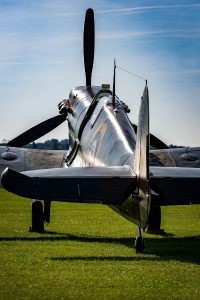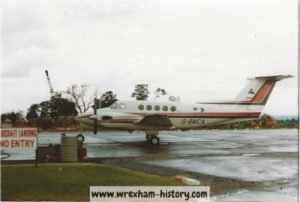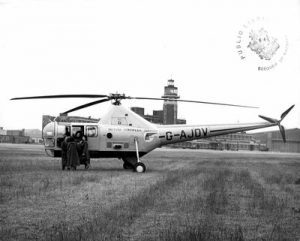History of Borras Airfield: The first mention of anything aviation-related in Wrexham was back in 1912 when Gustav Hamel held an air show on the Racecourse. The council consequently discussed turning the ground into a municipal airport!
Humble Beginnings
The municipal airport eventually appeared on the fields at Borras Lodge. The Royal Flying Corps used it for training purpose from 1917 to 1920, as did The Royal Air Force from 1918. In the 1930s, various local aero clubs and an aviation circus used the site.
Sir Alfred McAlpine carried out construction on the airfield for the Government in 1940-41, and it became known as RAF Wrexham.
The aerodrome was on a plateau and had no problem with drainage, unlike nearby RAF Sealand and RAF Hawarden. This favourable feature meant that Supermarine Spitfires from RAF Ternhill were regular visitors during inclement weather. After World War II broke out, No 5 Service Flying Training School RAF used Borras as a “relief strip”. Although the dry surface conditions attracted planes from other training groups, there were several “incidents” due to the absence of air traffic control.

A Hardened Nuclear Bunker
The airfield was placed into care and maintenance in 1946, although The Royal Observer Corps built a hardened nuclear bunker on the site in 1949 due to the Cold War. United Gravel Company, a subsidiary of Sir Alfred McAlpine, bought the airfield in 1959.
In the early 1970s, extensive quarrying for sand and gravel commenced on the site. United Gravel’s fleet of orange-cabbed Seddon Atkinson lorries, readily identifiable by the large letter A in a circle on the radiator grill, were a common sight on Wrexham’s roads.
Over the last 25 years, the ownership of the quarry has changed several times. The Breedon Group now operate the complex.
Alfred McAlpine
In the 1970s, Alfred McAlpine used to hold a very popular annual dance for its employees on the airfield. The dance took place in a marquee, with a free buffet, beer and cider.
Sir Alfred McAlpine and Son Ltd owned a Beech 200 Super King Air-BMCA aircraft. The aircraft was based at the airfield and would regularly fly in and out. On a few occasions, the pilot would take office staff for a joyride!

Related Wrexham Aviation Facts
Wrexham was a stop on the world’s first scheduled passenger helicopter service. The line ran between Liverpool, Wrexham and Cardiff from June 1950 to March 1951 with the return fare from Wrexham to Liverpool costing £1! The pad was on the site of The Range, Plas Coch Retail Park.

Five designated ‘Piper Cubstrips’ appeared in Wrexham during WWII. These were short airstrips suitable for use by US Army Piper Cubs. There were two at the RAF base in Borras, two in Acton and one opposite the Gresford Colliery entrance gates. Air Chief Marshall Sir Fred Rosier, one of Britain’s most senior airmen, was born in Wrexham in 1915. For the last years of his life, he lived at Sun Bank, Trevor.
Thanks to Wrexham History for providing us with this fascinating story.
We hope you enjoyed “History of Borras Airfield“. Click here for more of our history-related articles.
Main photo by Peter Bromley on Unsplash.

